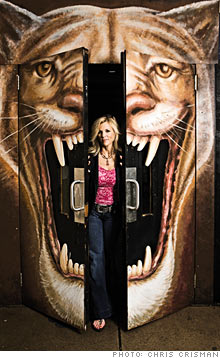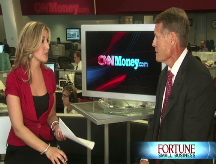HR software saves time and cash
Employee-evaluation software can help you reward stars and lose deadbeats.
 |
| Nittany's O'Leary-Rallis at her office in State College, Pa. |
(Fortune Small Business) -- At Nittany Embroidery & Screenprinting in State College, Pa., the employee-appraisal process was in tatters. To determine raises and bonuses for her 35 workers, CEO Erin O'Leary-Rallis relied on scribbled Post-it notes, hazy memories, and self-promoting testimonials from the employees.
Like most entrepreneurs, O'Leary-Rallis was not an HR specialist. She preferred to focus on creating new designs and drumming up business for her sportswear and customized-apparel company, which posted sales of around $3 million last year.
"I wasn't really prepared for employee evaluations, and I didn't have a hard-and-fast way of performing them," she says. Usually, they would be conducted only when the employee asked for one - giving bonus-hungry workers the upper hand. Too often she overpaid slackers and neglected star workers.
Instead of hiring an HR manager, the budget-conscious O'Leary-Rallis, 40, went hunting for a cheaper solution: talent-management software that helps do the job at a fraction of the cost in executive time and energy. Long popular with deep-pocketed corporations, talent-management software is now helping many small businesses automate the hard work of HR by keeping track of whether employees have met their goals and by even calculating the amount of compensation they deserve.
Naturally the idea of being managed by software makes some employees wary. But in most corporate settings it beats the alternative. "Paper-based performance appraisals are not a very comfortable process," says Lisa Rowan, an HR analyst at IDC, a market-intelligence firm. "So technology that can improve talent management has been welcomed with open arms."
O'Leary-Rallis sifted through some 20 software vendors that offer talent-management products, including Authoria, Halogen Software, Softscape, Taleo (TLEO), Workscape, and Workstream (WSTM). But it was SuccessFactors (SFSF), a web-based application from a company of the same name in San Mateo, Calif., that proved a perfect fit for Nittany.
Unlike its rivals, SuccessFactors aimed its product squarely at companies with fewer than 500 employees. It had the cheapest offering and was one of only two services to be entirely web-based (Taleo being the other). That meant Nittany's IT manager didn't have to spend any time or money hosting the service.
SuccessFactors is designed to look and feel like an e-mail application, but Nittany's managers found it harder to master than that description might suggest. It took six lengthy sessions on the phone with a SuccessFactors representative before Nittany's senior managers were up to speed on the system - far longer than O'Leary-Rallis anticipated. (SuccessFactors did not charge for the training.)
Here's how the system works: All Nittany employees have access to their own SuccessFactors in-box, which charts progress toward predefined goals. A member of the art department, say, can log on to SuccessFactors to see how many new embroidery designs she is expected to churn out in any given month - and note when she finishes one.
Each goal is worth a certain number of points, as are peer reviews and managerial appraisals. At review time, the points help determine the raise and bonus the employee gets. SuccessFactors does the math, based on the total number of points and the budget available. Employers can tweak the system to give, say, less weight to peer reviews.
O'Leary-Rallis saw immediate results. She was able to identify a lethargic employee who had long flown under the radar. He was perfectly affable, and O'Leary-Rallis had previously struggled to put her finger on exactly why he wasn't measuring up as a team player. Using SuccessFactors' metrics, "there's less wiggle room in terms of accountability," O'Leary-Rallis says. She and the employee agreed to part ways, allowing the company to reinvest his $25,000 salary in a more productive replacement.
Strong performers had also been suffering. One worker hadn't received a single raise in her 18 months with the company. A formal review using SuccessFactors, however, showed her to be one of the company's top performers. The star employee got an immediate $3,000 annual salary bump and a $2,000 bonus. "She had become an integral part of our organization," O'Leary-Rallis says. "Replacing her would have taken a lot of my time finding and training a suitable candidate."
Praise for the new system was hardly unanimous. Setting it up required much time-consuming data entry - reviewing peers, setting goals, tracking achievements - with little immediate reward. "I had one employee tell me we were putting too much thought into these things," says Alfred Bumbarger, Nittany's plant manager.
But the return on investment was clear. Nittany still has no HR manager, a position that would have cost O'Leary-Rallis a minimum of $12,000 a year if she had hired someone part-time. SuccessFactors costs her $75 an employee per year, producing annual savings of at least $10,000. The productivity benefits start with O'Leary-Rallis herself: She says the system has cut the time she spends on job coaching by nearly 30%.
Even for companies with HR professionals, a talent-management solution can ease the burden. Accounting firm Clark Nuber, based in Bellevue, Wash., deployed Halogen Software's talent-management suite three years ago, after CEO David Katri realized his paper-based appraisal process was "going to strangle us to death." Previously Excel spreadsheets had been passed around to as many as ten team members for evaluation of a single employee. The answers then had to be compiled manually and entered into a new spreadsheet.
Halogen's Multi-Rater feature solicits feedback from its employees via e-mail. It then incorporates these responses into a web-based appraisal system. Result: Clark Nuber's HR team saves about 170 hours annually on administrative tasks - or a total of $14,000 a year on an investment of $4,800.
Such savings may not impress the average employee. But back at Nittany, at least, all workers are now onboard with the new system. Even the dissenting employee decided that her work would be more fairly compensated with the help of software rather than by human managers alone. Score one for the machines. ![]()
Check out your HR software options with our gallery of 5 talent-management solutions.
More Tech Edge from the archives:
Boosting teamwork with wikis
Running an entire business from smartphones
Puree a rake for fun and profit
-
The Cheesecake Factory created smaller portions to survive the downturn. Play
-
A breeder of award-winning marijuana seeds is following the money and heading to the U.S. More
-
Most small businesses die within five years, but Amish businesses have a survival rate north of 90%. More
-
The 10 most popular franchise brands over the past decade -- and their failure rates. More
-
These firms are the last left in America making iconic products now in their twilight. More












